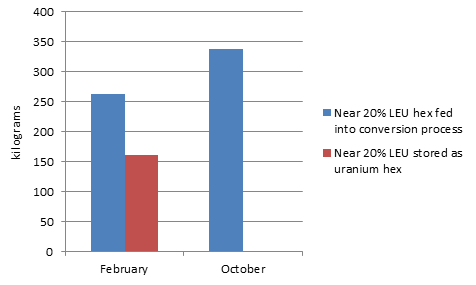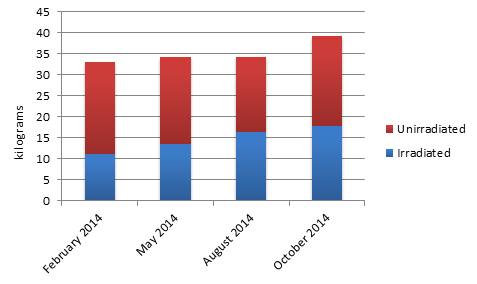Reports
Revisiting Iran’s Stock of Near 20 Percent LEU
by David Albright and Paulina Izewicz
November 18, 2014
On November 7, 2014, the International Atomic Energy Agency (IAEA) confirmed that Iran no longer has a stock of near 20 percent low enriched uranium (LEU) in hexafluoride form. However, Iran retains a large near 20 percent LEU stock in oxide form (see table 1 and figure 1). Moreover, the amount of near 20 percent LEU ending up in the Tehran Research Reactor (TRR) fuel assemblies is less than expected under a straightforward reading of the extension agreement of the Joint Plan of Action (JPA). The U.S. negotiators should seek to clarify this provision in the July 2014 extension agreement.
Previously, ISIS estimated that Iran fed into the conversion process at Esfahan a total of 337.1 kilograms of near 20 percent LEU hexafluoride. In September, the IAEA reported the precise amount fed as of August 17, 2014: 337.2 kilograms of near 20 percent LEU hexafluoride. It is convenient to consider only the mass of the uranium contained in this material, which is 227.6 kilograms. When giving the uranium mass, we state 227.6 kilograms (uranium mass) to help distinguish it from the mass in hexafluoride form.

** Includes 1.6 kg downblended previously Source: Implementation of the NPT Safeguards Agreement and relevant provisions of Security Council resolutions in the Islamic Republic of Iran, 5 September 2014; Status of Iran’s Nuclear Programme in relation to the Joint Plan of Action, July 20, 2014.

The conversion process resulted in the production of 162.3 kilograms (uranium mass) in oxide form. In its November 2014 report, the IAEA informed that an additional 0.5 kilograms were produced from the material which had previously been in the conversion process. This brings the total to 162.8 kilograms (uranium mass). A total of 54.4 kilograms (uranium mass) were contained in scrap, and about 10.4 kilograms (uranium mass) remained in the process and in waste.
LEU contained in scrap and in-process material would not be readily reconvertable. However, scrap material has significant value and Iran would be expected to recover much of it for conversion into usable uranium oxide. It would also be expected to reduce the amount of LEU in the conversion process lines to near zero. Overall, it is estimated that it would be able to recover up to 43 kilograms (uranium mass). Adding this quantity to the amount in oxide form gives a total of 205.8 kilograms (uranium mass).1 This total is equivalent to approximately 300 kilograms of near 20 percent LEU hexafluoride.
In sum, the quantity of the relatively easily reconvertable near 20 percent LEU (162.8 kilograms (uranium mass), is equivalent to 243.5 LEU hexafluoride. The total of reconvertable material is equivalent to approximately 300 kilograms near 20 percent LEU hexafluoride. These values compare to the often cited threshold of approximately 240-250 kilograms of near 20 percent LEU hexafluoride needed by itself to produce 25 kilograms of weapon-grade uranium, if reconverted to hexafluoride form and further enriched to weapon-grade. Thus, Iran retains a large and potentially dangerous amount of near 20 percent LEU, albeit it is an improvement that the material is in oxide rather than hexafluoride form.
Since the previous IAEA reporting period, Iran has manufactured three additional fuel assemblies for the TRR from near 20 percent LEU oxide. Thus far, Iran has manufactured five TRR test plates (75 grams each), nine control fuel rods (1,000 grams each), 21 standard fuel assemblies (1,400 grams each), and one test assembly (550 grams), for a total of 39 kilograms (uranium mass). In the TRR, Iran has irradiated two test plates (75 grams each), five control fuel assemblies (1,000 grams each) and nine (up from eight in the previous reporting period) standard fuel assemblies (1,400 grams each) – 17.75 kilograms in total.
The IAEA reported that Iran used a total of 75 kilograms of near 20 percent LEU oxide (uranium mass) to manufacture the TRR fuel. The fate of the 36 kilograms not in the fuel is not discussed. It could be in process lines, scrap, waste, or in storage tanks linked to the manufacturing process. It may be recoverable.
Reducing the Risk Posed by LEU Stockpile
When the interim period of the Joint Plan of Action was extended beyond its initial deadline of July 2014, Iran agreed that during the four-month period that it would fabricate 25 kilograms of its near 20 percent LEU oxide into fuel for the Tehran Research Reactor. When in fuel assemblies, the LEU is in a less reconvertable form.
In its September monthly report on the implementation of the JPA, the IAEA confirmed that Iran had used 12.5 kilograms for this purpose, and in its October report, that a total of 17.1 kilograms were used to manufacture fuel elements for the TRR.
However, not all of this material ended up in the fuel assemblies. In fact, little of this LEU appears to have ended in fuel assemblies. The amount of near 20 percent LEU oxide in TRR fuel assemblies has not changed significantly in the last several months. Figure 2 shows that since May 2014 until October 2014, the amount of near 20 percent LEU in fuel assemblies increased by only about 5 kilograms (uranium mass), far below the 25 kilograms expected under the extension of the interim deal. So, out of 17.1 kilograms used to manufacture fuel assemblies, only about 30 percent ended up in fuel assemblies.
A question is whether Iran committed to increasing the amount of LEU by 25 kilograms (uranium mass) that is actually in fuel assemblies or just feed that amount into the manufacturing lines regardless of how much ends up in the fuel itself. However, a simple reading of the July 2014 agreement would imply that much more than five kilograms of near 20 percent LEU oxide should end up in the fuel by November 24, the end of this interim period. This point should be reconciled by the negotiators.

Irradiate and Export Excess Near 20 Percent LEU
One way to further reduce the risk posed by the large near 20 percent LEU stock is to irradiate the LEU in the TRR, but this possibility does not appear possible over the life of a long term deal. Once irradiated, the LEU fuel poses a radiation risk and would need to be separated in heavily-shielded facilities, a difficult and time consuming process. As Iran continues to fuel TRR, more material will be irradiated. Thus, Iran would be unlikely to be able to draw upon its entire estimated stock of converted LEU oxide. Over the next several years, however, the TRR, which is a small reactor, is expected to irradiate less than the equivalent of tens of kilograms of near 20 percent LEU hexafluoride. Thus, irradiation is not expected to be a viable option to reduce the risk posed by the near 20 percent LEU.
Although it should be noted that LEU contained in fuel assemblies is recoverable, the process would take longer than if the material was in uranium oxide powder form. One possible compromise in a comprehensive solution would be for Iran to manufacture its entire stock of near 20 percent LEU into fuel assemblies. But this method is not entirely satisfactory either.
Alternatively, Iran and the P5+1 could agree upon an excess amount of near 20 percent LEU that would be blended down to below five percent LEU or shipped overseas. If shipped overseas, the LEU would return only if a need to fuel a reactor is verifiably demonstrated.
1 This calculation is based on the assumption that about 70 percent of LEU in scrap, and about 50 percent of the in-process inventory could be recovered. For a more detailed discussion of the reconvertability of different chemical forms of uranium, see: David Albright, Patrick Migliorini, Christina Walrond, and Houston Wood, “Update on Iran’s Total Near 20 Percent Enriched Uranium Stock: Nearly Enough for a Bomb, if Further Enriched,” ISIS Report, March 11, 2014, http://isis-online.org/uploads/isis-reports/documents/twenty_percent_stock_march_11_2014-final.pdf

 twitter
twitter